[English] 日本語
 Yorodumi
Yorodumi- PDB-8hlr: Human ADP-ribosyltransferase 1 (PARP1) catalytic domain bound to ... -
+ Open data
Open data
- Basic information
Basic information
| Entry | Database: PDB / ID: 8hlr | ||||||||||||
|---|---|---|---|---|---|---|---|---|---|---|---|---|---|
| Title | Human ADP-ribosyltransferase 1 (PARP1) catalytic domain bound to Fluzoparib (SHR3162) | ||||||||||||
 Components Components | Poly [ADP-ribose] polymerase 1, processed C-terminus | ||||||||||||
 Keywords Keywords | TRANSFERASE / DNA ADP-ribosyltransferase 1 / PARP1 / Fluzoparib / SHR3162 | ||||||||||||
| Function / homology |  Function and homology information Function and homology informationNAD+-histone H2BS6 serine ADP-ribosyltransferase activity / NAD+-histone H3S10 serine ADP-ribosyltransferase activity / NAD+-histone H2BE35 glutamate ADP-ribosyltransferase activity / positive regulation of myofibroblast differentiation / negative regulation of ATP biosynthetic process / NAD+-protein-tyrosine ADP-ribosyltransferase activity / NAD+-protein-histidine ADP-ribosyltransferase activity / regulation of base-excision repair / positive regulation of single strand break repair / regulation of circadian sleep/wake cycle, non-REM sleep ...NAD+-histone H2BS6 serine ADP-ribosyltransferase activity / NAD+-histone H3S10 serine ADP-ribosyltransferase activity / NAD+-histone H2BE35 glutamate ADP-ribosyltransferase activity / positive regulation of myofibroblast differentiation / negative regulation of ATP biosynthetic process / NAD+-protein-tyrosine ADP-ribosyltransferase activity / NAD+-protein-histidine ADP-ribosyltransferase activity / regulation of base-excision repair / positive regulation of single strand break repair / regulation of circadian sleep/wake cycle, non-REM sleep / vRNA Synthesis / carbohydrate biosynthetic process / NAD+-protein-serine ADP-ribosyltransferase activity / negative regulation of adipose tissue development / NAD DNA ADP-ribosyltransferase activity / DNA ADP-ribosylation / mitochondrial DNA metabolic process / regulation of oxidative stress-induced neuron intrinsic apoptotic signaling pathway / replication fork reversal / ATP generation from poly-ADP-D-ribose / positive regulation of necroptotic process / transcription regulator activator activity / response to aldosterone / HDR through MMEJ (alt-NHEJ) / positive regulation of DNA-templated transcription, elongation / NAD+ ADP-ribosyltransferase / signal transduction involved in regulation of gene expression / negative regulation of telomere maintenance via telomere lengthening / protein auto-ADP-ribosylation / mitochondrial DNA repair / NAD+-protein-aspartate ADP-ribosyltransferase activity / protein poly-ADP-ribosylation / positive regulation of intracellular estrogen receptor signaling pathway / negative regulation of cGAS/STING signaling pathway / positive regulation of cardiac muscle hypertrophy / NAD+-protein-glutamate ADP-ribosyltransferase activity / positive regulation of mitochondrial depolarization / cellular response to zinc ion / NAD+-protein mono-ADP-ribosyltransferase activity / nuclear replication fork / decidualization / protein autoprocessing / R-SMAD binding / site of DNA damage / macrophage differentiation / negative regulation of transcription elongation by RNA polymerase II / Transferases; Glycosyltransferases; Pentosyltransferases / NAD+ poly-ADP-ribosyltransferase activity / positive regulation of SMAD protein signal transduction / POLB-Dependent Long Patch Base Excision Repair / SUMOylation of DNA damage response and repair proteins / positive regulation of double-strand break repair via homologous recombination / nucleosome binding / protein localization to chromatin / nucleotidyltransferase activity / telomere maintenance / transforming growth factor beta receptor signaling pathway / negative regulation of innate immune response / nuclear estrogen receptor binding / response to gamma radiation / mitochondrion organization / Downregulation of SMAD2/3:SMAD4 transcriptional activity / enzyme activator activity / protein-DNA complex / cellular response to nerve growth factor stimulus / DNA Damage Recognition in GG-NER / protein modification process / Dual Incision in GG-NER / positive regulation of protein localization to nucleus / Formation of Incision Complex in GG-NER / histone deacetylase binding / cellular response to insulin stimulus / NAD binding / cellular response to amyloid-beta / cellular response to UV / nuclear envelope / double-strand break repair / regulation of protein localization / site of double-strand break / cellular response to oxidative stress / transcription regulator complex / damaged DNA binding / RNA polymerase II-specific DNA-binding transcription factor binding / transcription by RNA polymerase II / chromosome, telomeric region / positive regulation of canonical NF-kappaB signal transduction / nuclear body / innate immune response / DNA repair / negative regulation of DNA-templated transcription / apoptotic process / DNA damage response / ubiquitin protein ligase binding / chromatin binding / protein kinase binding / chromatin / nucleolus / enzyme binding / negative regulation of transcription by RNA polymerase II / protein homodimerization activity Similarity search - Function | ||||||||||||
| Biological species |  Homo sapiens (human) Homo sapiens (human) | ||||||||||||
| Method |  X-RAY DIFFRACTION / X-RAY DIFFRACTION /  SYNCHROTRON / SYNCHROTRON /  MOLECULAR REPLACEMENT / Resolution: 2.85 Å MOLECULAR REPLACEMENT / Resolution: 2.85 Å | ||||||||||||
 Authors Authors | Wang, X.Y. / Zhou, J. / Xu, B.L. | ||||||||||||
| Funding support |  China, 3items China, 3items
| ||||||||||||
 Citation Citation |  Journal: Bioorg.Chem. / Year: 2025 Journal: Bioorg.Chem. / Year: 2025Title: Engaging an engineered PARP-2 catalytic domain mutant to solve the complex structures harboring approved drugs for structure analyses. Authors: Wang, X. / Zhou, J. / Xu, B. | ||||||||||||
| History |
|
- Structure visualization
Structure visualization
| Structure viewer | Molecule:  Molmil Molmil Jmol/JSmol Jmol/JSmol |
|---|
- Downloads & links
Downloads & links
- Download
Download
| PDBx/mmCIF format |  8hlr.cif.gz 8hlr.cif.gz | 151.6 KB | Display |  PDBx/mmCIF format PDBx/mmCIF format |
|---|---|---|---|---|
| PDB format |  pdb8hlr.ent.gz pdb8hlr.ent.gz | 116.1 KB | Display |  PDB format PDB format |
| PDBx/mmJSON format |  8hlr.json.gz 8hlr.json.gz | Tree view |  PDBx/mmJSON format PDBx/mmJSON format | |
| Others |  Other downloads Other downloads |
-Validation report
| Summary document |  8hlr_validation.pdf.gz 8hlr_validation.pdf.gz | 963 KB | Display |  wwPDB validaton report wwPDB validaton report |
|---|---|---|---|---|
| Full document |  8hlr_full_validation.pdf.gz 8hlr_full_validation.pdf.gz | 971.4 KB | Display | |
| Data in XML |  8hlr_validation.xml.gz 8hlr_validation.xml.gz | 26.1 KB | Display | |
| Data in CIF |  8hlr_validation.cif.gz 8hlr_validation.cif.gz | 34.7 KB | Display | |
| Arichive directory |  https://data.pdbj.org/pub/pdb/validation_reports/hl/8hlr https://data.pdbj.org/pub/pdb/validation_reports/hl/8hlr ftp://data.pdbj.org/pub/pdb/validation_reports/hl/8hlr ftp://data.pdbj.org/pub/pdb/validation_reports/hl/8hlr | HTTPS FTP |
-Related structure data
| Related structure data | 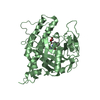 8hknC  8hkoC 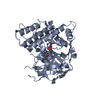 8hksC  8hljC  8hlqC C: citing same article ( |
|---|---|
| Similar structure data | Similarity search - Function & homology  F&H Search F&H Search |
- Links
Links
- Assembly
Assembly
| Deposited unit | 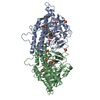
| ||||||||||||
|---|---|---|---|---|---|---|---|---|---|---|---|---|---|
| 1 | 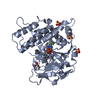
| ||||||||||||
| 2 | 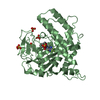
| ||||||||||||
| Unit cell |
|
- Components
Components
| #1: Protein | Mass: 39555.270 Da / Num. of mol.: 2 Source method: isolated from a genetically manipulated source Source: (gene. exp.)  Homo sapiens (human) / Gene: PARP1, ADPRT, PPOL / Production host: Homo sapiens (human) / Gene: PARP1, ADPRT, PPOL / Production host:  #2: Chemical | Mass: 472.395 Da / Num. of mol.: 2 / Source method: obtained synthetically / Formula: C22H16F4N6O2 / Feature type: SUBJECT OF INVESTIGATION #3: Chemical | ChemComp-SO4 / #4: Water | ChemComp-HOH / | Has ligand of interest | Y | Has protein modification | N | |
|---|
-Experimental details
-Experiment
| Experiment | Method:  X-RAY DIFFRACTION / Number of used crystals: 1 X-RAY DIFFRACTION / Number of used crystals: 1 |
|---|
- Sample preparation
Sample preparation
| Crystal | Density Matthews: 2.35 Å3/Da / Density % sol: 47.59 % |
|---|---|
| Crystal grow | Temperature: 291 K / Method: vapor diffusion, hanging drop / Details: 2.5 M ammonium sulfate, 100 mM Tris-HCl, pH 7.5 |
-Data collection
| Diffraction | Mean temperature: 100 K / Serial crystal experiment: N |
|---|---|
| Diffraction source | Source:  SYNCHROTRON / Site: SYNCHROTRON / Site:  SSRF SSRF  / Beamline: BL02U1 / Wavelength: 0.979183 Å / Beamline: BL02U1 / Wavelength: 0.979183 Å |
| Detector | Type: DECTRIS EIGER X 16M / Detector: PIXEL / Date: Aug 20, 2022 |
| Radiation | Protocol: SINGLE WAVELENGTH / Monochromatic (M) / Laue (L): M / Scattering type: x-ray |
| Radiation wavelength | Wavelength: 0.979183 Å / Relative weight: 1 |
| Reflection | Resolution: 2.85→46.79 Å / Num. obs: 17378 / % possible obs: 95.47 % / Redundancy: 7 % / Biso Wilson estimate: 47.57 Å2 / CC1/2: 0.997 / Net I/σ(I): 15.01 |
| Reflection shell | Resolution: 2.85→2.952 Å / Num. unique obs: 1669 / CC1/2: 0.782 |
- Processing
Processing
| Software |
| |||||||||||||||||||||||||||||||||||||||||||||||||
|---|---|---|---|---|---|---|---|---|---|---|---|---|---|---|---|---|---|---|---|---|---|---|---|---|---|---|---|---|---|---|---|---|---|---|---|---|---|---|---|---|---|---|---|---|---|---|---|---|---|---|
| Refinement | Method to determine structure:  MOLECULAR REPLACEMENT / Resolution: 2.85→46.79 Å / SU ML: 0.2552 / Cross valid method: FREE R-VALUE / σ(F): 1.36 / Phase error: 26.599 MOLECULAR REPLACEMENT / Resolution: 2.85→46.79 Å / SU ML: 0.2552 / Cross valid method: FREE R-VALUE / σ(F): 1.36 / Phase error: 26.599 Stereochemistry target values: GeoStd + Monomer Library + CDL v1.2
| |||||||||||||||||||||||||||||||||||||||||||||||||
| Solvent computation | Shrinkage radii: 0.9 Å / VDW probe radii: 1.1 Å / Solvent model: FLAT BULK SOLVENT MODEL | |||||||||||||||||||||||||||||||||||||||||||||||||
| Displacement parameters | Biso mean: 46.4 Å2 | |||||||||||||||||||||||||||||||||||||||||||||||||
| Refinement step | Cycle: LAST / Resolution: 2.85→46.79 Å
| |||||||||||||||||||||||||||||||||||||||||||||||||
| Refine LS restraints |
| |||||||||||||||||||||||||||||||||||||||||||||||||
| LS refinement shell |
|
 Movie
Movie Controller
Controller


 PDBj
PDBj








